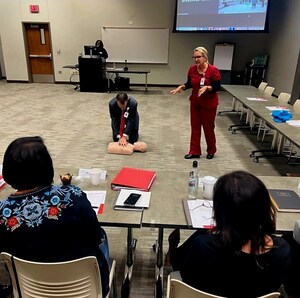Report Highlights:
-- An American Heart Association paper underscores the need for policy interventions to improve health and reduce death from heart disease and stroke.
-- The paper highlights specific policy recommendations to improve quality of care and the environment to promote healthy behaviors.
DALLAS, Jan. 18, 2011 /PRNewswire-USNewswire/ -- The American Heart Association has, for the first time, published a statement, "American Heart Association and Nonprofit Advocacy: Past, Present, and Future," that documents the association's longstanding commitment to improve heart and stroke-related public policy.
(Logo: http://photos.prnewswire.com/prnh/20100222/AHSALOGO)
The paper, published in Circulation: Journal of the American Heart Association, highlights the association's 2011 recommendations as lawmakers face difficult budget decisions, including the potential slashing for heart disease and stroke research and prevention initiatives. The statement illustrates the importance of patient-centered advocacy to support innovative research, quality care and prevention programs as America's greatest health threats continue to escalate.
"Public policy is a key component for improving the public's health because it addresses the overall environment of where people live, eat, work and receive health care," said Larry B. Goldstein, M.D., chair of the writing group and professor of medicine and director of the Duke Stroke Center at Duke University Medical Center in Durham, N.C.
"It also addresses something many people aren't aware of — government funding for research on preventing and treating heart attacks, congestive heart failure, stroke and other cardiovascular diseases."
Key American Heart Association federal policy issues for 2011 include:
- Advocating more funding for research for the National Institutes of Health and looking for new avenues for funding, such as the Department of Defense budget.
- Endorsing reauthorization of the FIT Kids Act, which would amend the Elementary and Secondary Education Act (No Child Left Behind) to ensure that kids are active during the school day and stay healthy through diet and exercise.
- Funding for the Centers for Disease Control and Prevention's Heart Disease and Stroke Prevention programs.
- Ensuring prevention-related provisions in health reform implementation.
- Improved food labeling.
- Robust nutrition standards for foods sold in schools and served in meals.
- Providing input, including on cigarette pack warning labels, for the new FDA Regulation of Tobacco Law.
The 2011 state public policy priorities include:
- Requiring quality physical education and health education in schools.
- Requiring nutrition standards for competitive foods to ensure healthy foods are offered in schools.
- Prohibiting trans fat in school and restaurant foods.
- Promoting a healthy community environment including recreational spaces, walking/biking trails and increasing restaurant menu labeling with calorie, serving sizes and sodium information.
- Supporting smoke-free workplaces, restaurants and bars.
- Supporting significant increases in tobacco excise taxes and comprehensive tobacco control, prevention and treatment programs.
- Funding heart disease and stroke prevention programs in state health departments.
- Promoting public policies that ensure quality health care through adherence to evidence-based guidelines and treatment protocols.
- Monitoring opportunities within states' health reform implementation as part of the Patient Protection and Affordable Care Act, including increasing insurance coverage for evidence-based preventive services.
- Recommending CPR training as a requirement for high school graduation.
- Developing coordinated systems of care for stroke, cardiac arrest and ST-elevation myocardial infarction, or STEMI.
- Eliminating healthcare disparities among races, ethnicities and genders, and improving health equity.
The association translates robust science into policy that provides a foundation for its legislative and regulatory advocacy activities.
"To achieve the American Heart Association's 2020 goal — to improve the cardiovascular health of all Americans by 20 percent while reducing deaths from cardiovascular diseases and stroke by 20 percent — we need to fight heart disease, congestive heart failure, stroke and other cardiovascular diseases on two fronts," said Nancy Brown, CEO of the American Heart Association.
"Helping individuals make healthier choices is one part of the equation. The other part is public policy at the federal, state and local level where we advocate for health-promoting environments where people can get physical activity safely, find healthy, affordable foods easily and receive quality healthcare."
Previous association advocacy efforts have led to measurable health successes, said Ralph Sacco, M.D., American Heart Association president. These include improvements in: smoking cessation; nutrition standards in schools; CPR training; Good Samaritan laws; and placement of automated external defibrillators (AEDs) in public places.
"Advocacy around smoking cessation and prevention has been an American Heart Association/American Stroke Association priority for several decades and is a remarkable example of the impact advocacy can have on reducing cardiovascular diseases and stroke in the United States," Sacco said. "Efforts by the association have contributed to a more than 25 percent decline in deaths from cardiac disease and stroke and a decline in U.S. cigarette consumption by more than 24 percent over the last decade. Despite this progress, 23.1 percent of men and 18.3 percent of women in the U.S. still smoke. This is why we need to remain vigilant in keeping this and other issues regarding achieving ideal cardiovascular health on the front burner."
The American Heart Association/American Stroke Association receives funding mostly from individuals. Foundations and corporations donate as well, and fund specific programs and events. Strict policies are enforced to prevent these relationships from influencing the association’s science content. Financial information for the American Heart Association, including a list of contributions from pharmaceutical companies and device manufacturers, is available at www.heart.org/corporatefunding.
NR11-1005 (Circ/Sacco, Brown, Goldstein)
CONTACT: |
|
Suzanne Ffolkes: (202) 785-7929 |
|
Darcy Spitz: (212) 878-5940 |
|
Julie Del Barto (broadcast): (214) 706-1330 |
|
SOURCE American Heart Association
WANT YOUR COMPANY'S NEWS FEATURED ON PRNEWSWIRE.COM?
Newsrooms &
Influencers
Digital Media
Outlets
Journalists
Opted In






Share this article